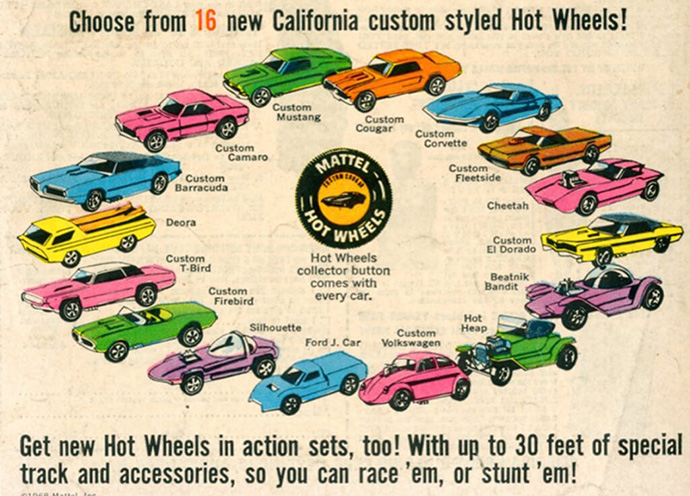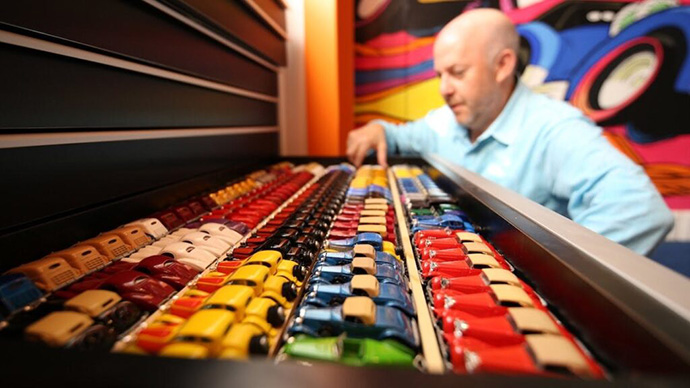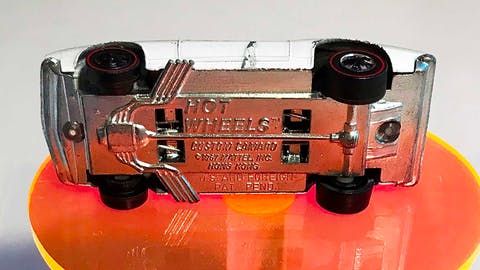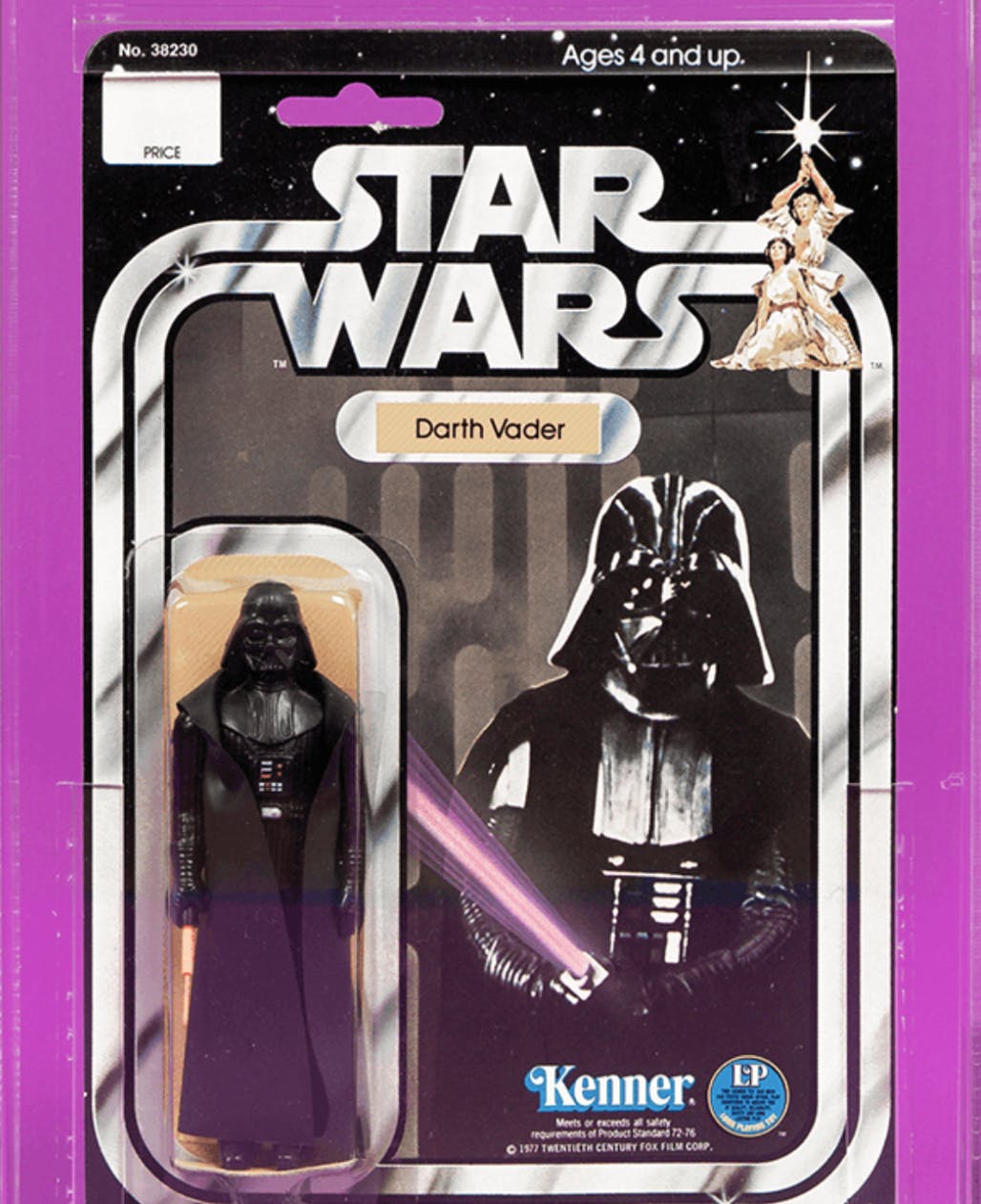This week we’re sticking with the theme of cars — toy cars, to be specific. We’re talking Hot Wheels.
This issue includes a special podcast with Bruce Pascal, one of the most famous collectors of Hot Wheels in the entire world.
Let’s go
Table of Contents
Podcast with Bruce Pascal
This week, Horacio sat down with Bruce Pascal, a real estate veteran from Maryland who has what is considered the world’s most valuable collection of Hot Wheels (4,000 cars valued at $1.8 million)
Bruce doesn’t have the world’s largest collection; that award goes to Michael Zarnock, who owns 30,000 cars. But his journey makes for a great story. The guy’s a true wheeler & dealer.
Bruce is a super nice & interesting guy, and has been featured in Barron’s, CNN, and more. We were excited to get him on the podcast, which turned out well. Have a listen!
History of Hot Wheels
Hot Wheels, LEGOs, and GI Joe. Those are the toys I remember most from childhood. And I wasn’t alone.
Hot Wheels have been delighting kids for what seems like forever — 53 years to be exact. Mattel first released them in 1968. Fresh off the success of the Barbie doll, Mattel’s founders wanted to create another big winner, but this time for boys.
Elliot Handler, Mattel’s co-founder, stumbled across the idea for Hot Wheels when he saw his son playing with a Matchbox car — an earlier, lamer version of Hot Wheels.
Handler’s idea was to create a competitor like Matchbox, except “cool.” The idea was these cars would be more like hot rods and fantasy vehicles, with flaming paint-jobs, outrageous proportions, and hefty superchargers. And so, Hot Wheels was born with the help of engineers, car designers, rocket scientists, and even Handler’s son.
Sixteen models of cars were released in 1968, each with varying colors, interior designs and modifications. This original line of Hot Wheels is affectionately dubbed as the “Sweet 16“, and they’re the most valuable Hot Wheels out there.

Since then, the company has sold over 4 billion die-cast cars, making them the #1 selling toy in the world, with 17 Hot Wheels sold every second. Their product line includes model cars, race tracks, countless merchandise, four films, and sixteen video games.
Part of the appeal of Hot Wheels was the speed they could reach. An entire sub-economy has sprouted up around racing them, like this crazy custom racetrack that took four years to build.

But Hot Wheels cars are no longer just fun to play with — they’re a serious collector’s item.
What makes Hot Wheels a good investment?
Mattel has done a terrific job of brand stewardship, staying relevant over the decades with Tesla Hot Wheels, plus-sized Barbies, and more. But I think the huge tailwind here is nostalgia.
Nostalgia is one of the strangest, most irreplaceable emotions that humans experience.
As we grow older, we become more reflective, thinking about the things we loved as kids. We’re all suckers for the warm & fuzzy “good ol’ days” — no matter how inaccurate it may be.
Wildly popular items during one generation tend to resurge in popularity decades later, when the kids have become adults. Advertisers are starting to take notice, and nostalgia marketing is getting big. (It especially seems to resonate with stressed and overwhelmed millennials, who may crave simpler times before student loans & million-dollar starter homes.)
To me, what’s funny about nostalgia is how it never goes away. It repeats every generation, or even micro-generation (long live the Oregon Trail Generation baby!) Every new batch of society feels nostalgia for different periods. The popular stuff from your childhood means nothing to your kids. The lame songs you hate today will mean everything to them.
And on and on it goes, forever.
We’ve seen this play out with so many things: trading cards, memorabilia, vinyl records, vintage Instagram filters, and yes, Hot Wheels.

Bruce got started with a Beach Bomb
Twenty years ago, when Bruce started getting into collecting Hot Wheels, the rarest and most expensive Hot Wheel was a 1969 Volkswagen Pink Rear-Loading Beach Bomb.
The reason for its high price? The toy never worked! Whereas other models could be raced, the weight distribution on the Volkswagen Beach Bomb was way off, causing it to fall over.
The toy was never released to the public, and to this day, most collectors believe just two of these cars were ever manufactured. Ultra-rare.
Bruce made it his mission to purchase one of them, and in 1999 he succeeded. It set him back $72,000 – by far the most expensive Hot Wheels car ever sold at the time.

It’s been twenty years, and Bruce’s investment has proved to be a smart one. His Pink Volkswagen Beach Bomb is valued at roughly $150,000 – $185,000, more than twice what he paid. He was so proud of this purchase, it’s the name of his Instagram.
So who owns the other Beach Bomb?
Yeah, Bruce owned that too. But instead of cornering the market, he sold it to a friend.
(Bruce was later accused of owning a fake. But we get into that in the podcast)
How are Hot Wheels valued?
Condition
Condition is everything.
This is because valuing Hot Wheels and their condition isn’t an exact science. There’s no accepted grading body (like the Collectors Universe conglomerate, which owns PSA, Goldin Auctions Wata Games, and now Card Ladder) that objectively determines value.
This means investors themselves have to determine how bad scratches and nicks are.
Like action figures and other toys, anything sealed-in-box is the holy grail. But from there, it goes downhill quickly.
For example, an original Blue Camaro sealed in its package can fetch upwards of $1,500. But it’s in mint condition without the original packaging? Chop the price in half. Does it have nicks & chipped paint? Boom, the value can sink to $30.
Having a car in poor condition doesn’t mean much. As far as collectors are concerned, you might as well not have one.


Rarity
Once a new product comes off the shelves, the aftermarket flurry kicks in. New stock hits eBay and other platforms and opens up flipping opportunities. (eBay has a massive Hot Wheels resale market. And Bruce is all over it.)
Age is hugely important, and the rarest Hot Wheels cars usually come from the early era (1968-72). Some of these models have been off the market for fifty years.
After unreleased prototypes like the Beach Bomb, the most desirable models are the ‘Sweet Sixteen’ release. These OG cars form the cornerstone of any valuable collection. You need these to matter.
Design
Rarity of color can increase the price. Mattel may have released 20 million 1968 Camaros in blue, but only 50,000 in bright red. The red ones will be worth more.
The color of the interior and especially physical modifications can increase rarity & price.
Casting location
One occasionally overlooked value marker is where the car was cast. You can tell where most models were die-cast by looking at their underside.
Models are made in the USA and Hong Kong. Vehicles cast in the USA are often more valuable than their Hong Kong counterparts.

How to invest in Hot Wheels
So, where do you find vintage Hot Wheels?
It can be tempting to rush into a purchase, but Bruce strongly recommends against this.
It’s never a good idea to invest in something you haven’t done your due diligence on. But this is particularly an issue with Hot Wheels. The lack of a reputable grading service creates a steeper learning slope than other collectibles.
To quickly level up, you’ll can nerd out in some Hot Wheels communities.
If physical books are your thing, Hot Wheels: A Collector’s Guide by Bob Parker is an extensive catalog of everything up through 1999.
For the most up-to-date pricing, check out the Hot Wheels price guides from Hallsguide.com
Tips for buying Hot Wheels
The easiest way is to check your attic. Ask your parents and their friends. Even if you don’t personally remember saving your childhood collection, there’s a chance someone you know had the foresight to.
Beyond that, you can source collections in two main ways: online, or physical. Bruce recommends physical.
Since Hot Wheels were released over five decades ago, many original collectors are unfortunately passing away. However, this opens up the opportunity for newer investors to snare a valuable collection to a seller who is none the wiser.
Look for estate sales. Bruce estimates that 1 in every 50 estate sales has a Hot Wheels collection, and 60% of those collections will be in very rough shape. So you have roughly a 1-2% chance of finding a goldmine.
Okay, not exactly encouraging. But it makes the hunt all the more rewarding. And who knows what else you might find? Old baseball cards, action figures, books, manuscripts, artwork, photographs, video games, you name it. Estate sales can be a goldmine.

The other way to find Hot Wheels is, of course, online. But since everyone has access to the same pricing data, it’s tougher to find those absurdly good deals at an estate sale.
Likewith so much else, with Hot Wheels you make money when you buy, not when you sell. If you look online, use price guides to ensure you don’t overpay. Bruce typically pays anywhere from 65%–105% of market value for top models. But at estate sales, you’ll rarely pay more than 50% of market value.
Shipping can be costly, so don’t bother buying one model a time unless you want something specific. The best deals are found when buying a large collection. Bruce discovered an entire garage full of cars, including some seriously valuable models. He was quoted $3,000 – $5,000 to ship it back to his Maryland warehouse, but that’s how you gotta do it.
Bruce ended up getting rid of 60% of those cars. He’s optimizing for value, not size.
Conclusion
Twenty years ago, if you told someone you collected Hot Wheels, they’d probably give you a weird look.
Not anymore. The Hot Wheels brand is strong, collectors have noticed, and society’s acceptance level has gone from a 1 to a 7. News specials, Facebook/Instagram posts, and auction houses have legitimized Hot Wheels collecting as a viable investment opportunity. There is still ample room for growth in this market.
The next big step for Hot Wheels for this market is grading. Suppose Collectors Universe or another respected company creates a new universal grading template. The barrier to entry will drop, pricing will stabilize, and the market will get kicked up a notch. All of this drives up demand and value.
Hot Wheels are still a relatively niche investment, and probably an undervalued market. It’s very low cost, low risk, and there is very little sealed inventory left.
So bug everyone you know to find their old collections, and hit up those estate sales!* Before you know it you could have a pretty cool collection going.
*You gotta be quick though. Bruce will probably beat you to this.













